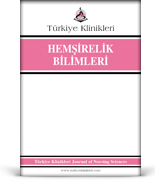Amaç: Doğurganlık; klinik gebelik oluşturma kapasitesi olarak tanımlanmaktadır. Kadınlar yaşamlarının bir döneminde anne olmak istemekte fakat günümüz de birçok neden kadınlarda doğurganlık kaybına sebep olmaktadır. Bu çalışma, kadınların doğurganlığı algılama durumları ve doğurganlık kaybı ile karşı karşıya kaldıklarında, bu durumun yaşamlarında ne ifade ettiğini belirlemek amacıyla planlanmıştır. Gereç ve Yöntemler: Bu çalışma betimleyici niteliksel bir araştırma olarak planlanmıştır. Araştırmaya ölçüt örnekleme yöntemi ile 34 kadın katılmıştır. Örneklem sayısı, veri doygunluğu ilkesine göre belirlenmiştir. Yeterli veri topladığı veri doygunluğuna ulaşıldığı düşündüğünde görüşme sonlandırmıştır. Araştırma verileri; tanıtıcı bilgi formu (5 soru) ve yarı yapılandırılmış görüşme formu (5 açık uçlu soru) ile toplanmıştır. Verileri analiz etmek için Graneheim ve Lundman (2004) yöntemi kullanıldı. Araştırmacılar, verileri değerlendirirken kadınlardan alınan ses kayıtları ve yazılı belgeler üzerinde manuel olarak içerik analizi gerçekleştirmiştir. Çıkarılan kodlar sürekli karşılaştırma yapılarak benzerlik ve farklılıklarına göre sınıflandırılmıştır. Kodlar daha sonra konularına göre alt temalara ayrılmış ve bu alt temalar daha sonra çalışmanın amaçlarına uygun olarak temalar halinde düzenlenmiştir. Bulgular: Çalışmaya katılanların yaşları 20 ile 49 arasında değişmekte olup, yaş ortalamaları 32,05'tir. Görüşmeler sırasında toplanan nitel veriler ile doğurganlık kaybı durumunu kapsamlı bir şekilde tanımlayan 4 ana tema ve 8 alt tema saptanmıştır. Ana temalar: 1) Doğurganlığın bu hayattaki yeri, 2) Neden doğurganlık azaldı, 3) Doğurganlık kaybında duygular, 4) Doğurganlıkta Kadın ve Erkeğin Rolü. Sonuç: Doğurganlık kaybı yaşamamış kadınların üreme konusuna derin bir anlam ve duygu yükledikleri gözlemlenmiştir. Bu anlam ve duyguların oluşumunda ve sürdürülmesinde eşlerin, aile bireylerinin, toplumsal yapıların ve kültürel normların önemli bir rol oynadığı düşünülmektedir. Özellikle ergenlik döneminde başlayacak cinsiyet eşitliği temelli eğitim programlarıyla farkındalık artırılmalı; kadınların üreme kararları üzerindeki öznel iradeleri desteklenmelidir. Üremenin yalnızca biyolojik bir zorunluluk değil, aynı zamanda bireysel ve sosyal bir tercih olduğu anlayışının yaygınlaştırılması büyük önem taşımaktadır.
Anahtar Kelimeler: Doğurganlık; infertilite; nitel
Objective: Fertility is defined as the capacity to create a clinical pregnancy. It is a fundamental human desire to become a mother at some point in one's life. However, numerous factors can contribute to the loss of fertility in women. This study was planned to explore women's perception of fertility and what it means in their lives when faced with fertility loss. Material and Methods: This study was planned as a qualitative phenomenological research project. Thirty-four women participated in the study. The research data were collected using an introductory information form (5 questions) and a semi-structured interview form (5 open-ended questions). In evaluating the data, the researchers manually conducted content analysis on the voice recordings and written documents taken from the women. The extracted codes were classified according to their similarities and differences using the constant comparison. The codes were then classified into sub-themes according to their subject matter, with these sub-themes subsequently organized into themes aligned with the study's objectives. This study was designed as a descriptive qualitative research utilizing a criterion sampling method. A total of 34 women participated in the study, and the sample size was determined based on the principle of data saturation. Data collection was concluded when it was deemed that no new themes or insights were emerging and theoretical saturation had been achieved. Data were gathered using 2 tools: an introductory information form consisting of 5 questions to capture demographic and background information, and a semistructured interview form comprising 5 open-ended questions aimed at exploring participants' perceptions and experiences in depth. The data were analyzed using the Graneheim and Lundman (2004) content analysis method. Audio recordings and transcripts from the interviews were manually analyzed by the researchers through a systematic content analysis process. Initially, meaning units were identified and coded. These codes were then categorized based on similarities and differences using a constant comparison approach. The resulting categories were further organized into subthemes and ultimately into main themes, aligned with the objectives of the study. Results: The study participants ranged in age from 20 to 49, with an average age of 32.05. The qualitative data collected during the interviews identified 4 main themes and 8 sub-themes that comprehensively describe the situation of fertility loss. Main themes: 1) The place of fertility in this life, 2) Why fertility decreased, 3) Emotions in fertility loss 4) The Role of Women and Men in Fertility. Conclusion: A multitude of factors, including biological, psychological, and sociocultural elements, exert a considerable influence on fertility. Rather than attributing the responsibility for childbearing exclusively to women, it is imperative to emphasize the importance of promoting gender equality in optimizing the diagnosis and treatment of infertility. In this context, health professionals assume a pivotal role in identifying strategies that mitigate women's anxiety levels and facilitate stress management.
Keywords: Fertility; infertility; qualitative







.: Process List